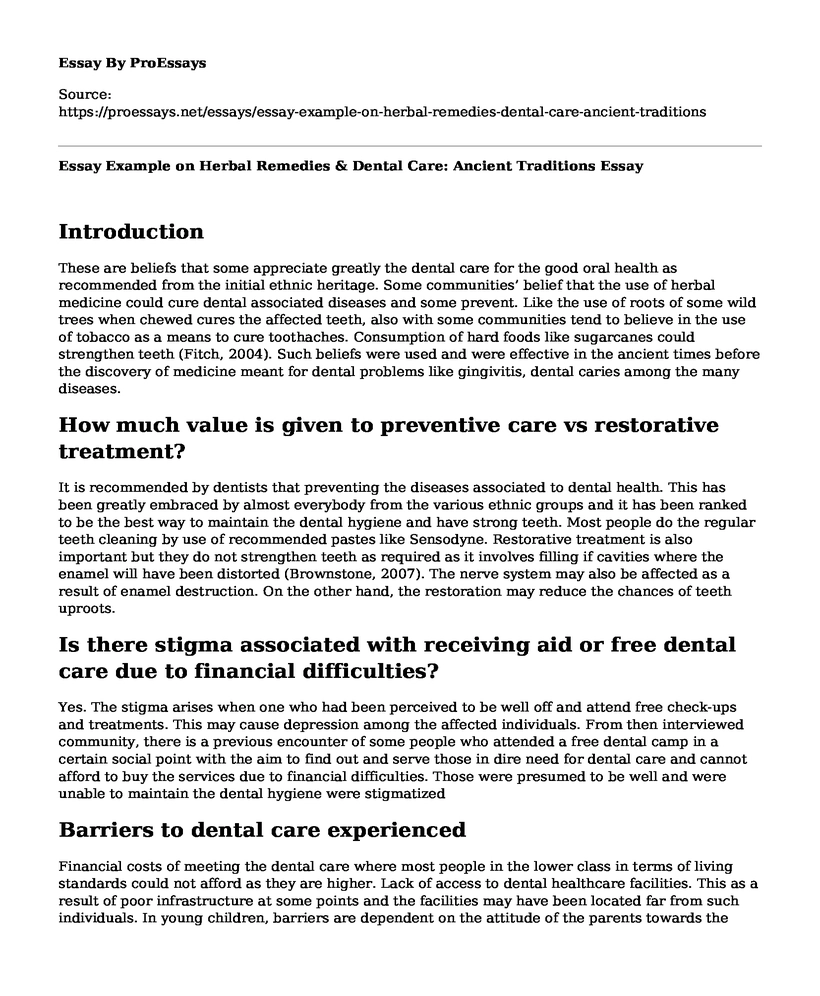Introduction
These are beliefs that some appreciate greatly the dental care for the good oral health as recommended from the initial ethnic heritage. Some communities’ belief that the use of herbal medicine could cure dental associated diseases and some prevent. Like the use of roots of some wild trees when chewed cures the affected teeth, also with some communities tend to believe in the use of tobacco as a means to cure toothaches. Consumption of hard foods like sugarcanes could strengthen teeth (Fitch, 2004). Such beliefs were used and were effective in the ancient times before the discovery of medicine meant for dental problems like gingivitis, dental caries among the many diseases.
How much value is given to preventive care vs restorative treatment?
It is recommended by dentists that preventing the diseases associated to dental health. This has been greatly embraced by almost everybody from the various ethnic groups and it has been ranked to be the best way to maintain the dental hygiene and have strong teeth. Most people do the regular teeth cleaning by use of recommended pastes like Sensodyne. Restorative treatment is also important but they do not strengthen teeth as required as it involves filling if cavities where the enamel will have been distorted (Brownstone, 2007). The nerve system may also be affected as a result of enamel destruction. On the other hand, the restoration may reduce the chances of teeth uproots.
Is there stigma associated with receiving aid or free dental care due to financial difficulties?
Yes. The stigma arises when one who had been perceived to be well off and attend free check-ups and treatments. This may cause depression among the affected individuals. From then interviewed community, there is a previous encounter of some people who attended a free dental camp in a certain social point with the aim to find out and serve those in dire need for dental care and cannot afford to buy the services due to financial difficulties. Those were presumed to be well and were unable to maintain the dental hygiene were stigmatized
Barriers to dental care experienced
Financial costs of meeting the dental care where most people in the lower class in terms of living standards could not afford as they are higher. Lack of access to dental healthcare facilities. This as a result of poor infrastructure at some points and the facilities may have been located far from such individuals. In young children, barriers are dependent on the attitude of the parents towards the dental plans and interests. The need perception among the people in the community (Choi, 2017). Some people may be attending dental clinics because of associated dental pains. Some people attend clinics on regular basis. Social factors may result to lower turn up rate as most people use public means of transport. Another barrier is the dental anxiety for some groups of people.
How does this culture influence the delivery/acceptance of dental hygiene care?
It fully supports the idea of dental care in the community. Basing on the responses regarding value of dental care in terms of preventive and restorative treatment clearly indicates that they embrace the dental hygiene care thus creating smooth running and delivery of dental care services. Stigmatization is not so rampant hence its effects is not so much considered to hinder the service delivery because there are only few cases (Choi, 2017). Since most people tend to know the importance of having regular visits to dental healthcare centers.
Would you have modify treatment in any way?
Somehow I could combine all what the community believe to cure the dental disorders to come up with a product which can be recommended by dentists. This is basically done if I stay close to the elders of the community.
References
Brownstone, E. G. (2007). A qualitative study of the occupational status and culture of dental hygiene in Canada. https://mspace.lib.umanitoba.ca/handle/1993/1666
Fitch, P. (2004). Cultural competence and dental hygiene care delivery: integrating cultural care into the dental hygiene process of care. Journal of Dental Hygiene, 78(1).
Choi, E. M., Noh, H. J., Chung, W. G., & Mun, S. J. (2017). Perception of infection control activities and patient safety culture among dental hygienists. Journal of Korean society of Dental Hygiene, 17(5), 769-777. http://www.koreascience.or.kr/article/JAKO201732663235869.page
Cite this page
Essay Example on Herbal Remedies & Dental Care: Ancient Traditions. (2023, Aug 08). Retrieved from https://proessays.net/essays/essay-example-on-herbal-remedies-dental-care-ancient-traditions
If you are the original author of this essay and no longer wish to have it published on the ProEssays website, please click below to request its removal:
- China and India: Nations' Health Comparison
- Essay Sample on Causes of Cancer
- Social Work Scholarship Application Letter
- Public Health Policy Analysis on Infectious Disease Reemergence - research-paper
- Essay Sample on Chronic Sleep Disorders & Sleep Loss: A Global Public Health Crisis
- Essay Example on Comparing RN & LPN: Differences in Qualification & Duties
- Essay on Youths' Increase in Hookah Smoking: Early Exposure & Mythical Beliefs







